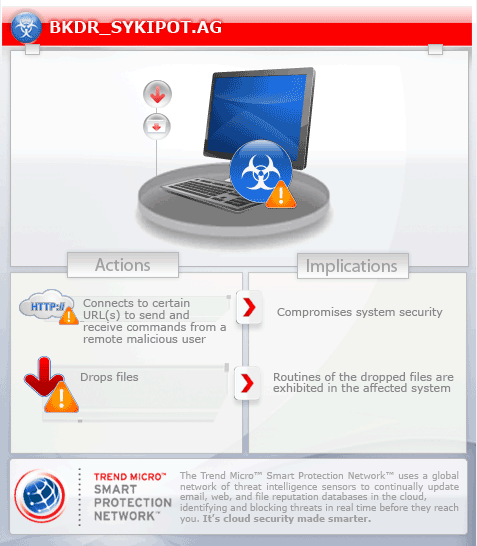BKDR_SYKIPOT.AG
Trojan.Win32.Spy (Ikarus), W32/SecRisk-ProcessPatcher-Sml-based!Maximus (FPROT)
Windows 2000, Windows XP, Windows Server 2003


Threat Type: Backdoor
Destructiveness: No
Encrypted:
In the wild: Yes
OVERVIEW
This backdoor is related to the Sykipot campaign that targets the United States civil aviation sector.
To get a one-glance comprehensive view of the behavior of this Backdoor, refer to the Threat Diagram shown below.

This backdoor arrives on a system as a file dropped by other malware or as a file downloaded unknowingly by users when visiting malicious sites.
It injects its dropped file/component to specific processes.
It executes commands from a remote malicious user, effectively compromising the affected system.
TECHNICAL DETAILS
Arrival Details
This backdoor arrives on a system as a file dropped by other malware or as a file downloaded unknowingly by users when visiting malicious sites.
Installation
This backdoor injects its dropped file/component to the following processes:
- outlook.exe
- firefox.exe
- chrome.exe
- opera.exe
- iexplore.exe
Autostart Technique
This backdoor adds the following registry entries to enable its automatic execution at every system startup:
HKEY_CURRENT_USER\Software\Microsoft\
Windows\CurrentVersion\Run
office = "%User Profile%\Local Settings\runtime.exe"
Backdoor Routine
This backdoor executes the following commands from a remote malicious user:
- sends system information (Computer name, IP address)
- downloads and execute component files.
It connects to the following URL(s) to send and receive commands from a remote malicious user:
- http://www.{BLOCKED}gvoter.org
Dropping Routine
This backdoor drops the following files:
- %User Profile%\Local Settings\runtime.exe - detected as BKDR_SYKIPOT.AG
- %User Profile%\Local Settings\wship4.tmp - detected as BKDR_SYKIPOT.AG
(Note: %User Profile% is the current user's profile folder, which is usually C:\Documents and Settings\{user name} on Windows 2000, XP, and Server 2003, or C:\Users\{user name} on Windows Vista and 7.)
SOLUTION
Step 1
Before doing any scans, Windows XP, Windows Vista, and Windows 7 users must disable System Restore to allow full scanning of their computers.
Step 2
Restart in Safe Mode
Step 3
Delete this registry value
Important: Editing the Windows Registry incorrectly can lead to irreversible system malfunction. Please do this step only if you know how or you can ask assistance from your system administrator. Else, check this Microsoft article first before modifying your computer's registry.
- In HKEY_CURRENT_USER\Software\Microsoft\Windows\CurrentVersion\Run
- office = %User Profile%\Local Settings\runtime.exe
- office = %User Profile%\Local Settings\runtime.exe
Step 4
Search and delete these files
- %User Profile%\Local Settings\runtime.exe
- %User Profile%\Local Settings\wship4.tmp
Step 5
Restart in normal mode and scan your computer with your Trend Micro product for files detected as BKDR_SYKIPOT.AG. If the detected files have already been cleaned, deleted, or quarantined by your Trend Micro product, no further step is required. You may opt to simply delete the quarantined files. Please check this Knowledge Base page for more information.
Did this description help? Tell us how we did.


